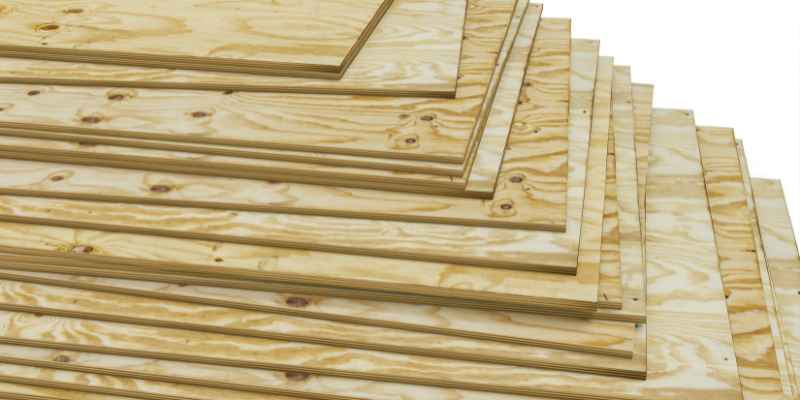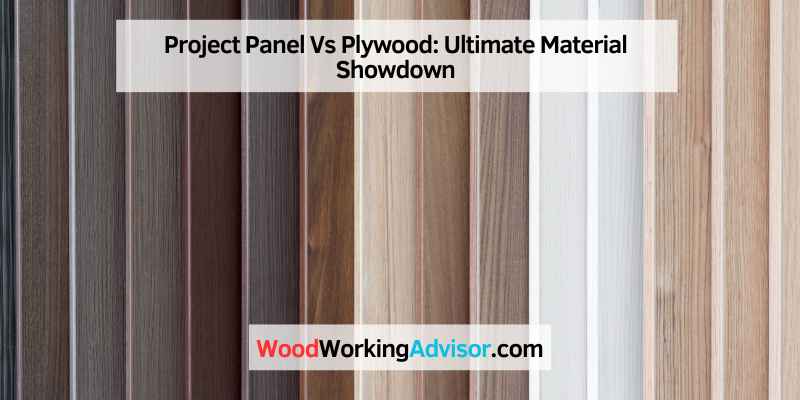Project panels are engineered wood products, while plywood is made of layers of wood veneers. Both materials are commonly used in construction and furniture making.
Project panels offer consistent quality and cost-effectiveness, while plywood provides strength and durability. Project panels and plywood are versatile building materials that offer strength, durability, and cost-effectiveness. Whether you’re working on a construction project or crafting furniture, understanding the differences between these two materials can help you make informed decisions.
We’ll explore the characteristics of project panels and plywood, their uses, and the factors to consider when choosing between them. By the end, you’ll have a clearer understanding of which material is best suited for your specific project.
Introduction To Project Panel And Plywood
Learn about the key differences between project panels and plywood. Project panels are versatile and cost-effective, while plywood offers superior strength and durability for various construction projects. Both materials have unique characteristics to consider for your next DIY endeavor.
Brief History
Project Panel and Plywood have a rich history in the construction and DIY industry. Both materials have been used for many years due to their versatility and durability.
Current Uses In Construction And DIY Projects
Project Panel and Plywood are widely used in various construction and DIY projects. Let’s take a closer look at their current applications:
– Flooring: Both Project Panel and Plywood can be used as a durable and cost-effective flooring option. They provide a stable surface that can withstand heavy foot traffic.
– Furniture construction: Project Panel and Plywood are popular choices for building furniture due to their strength and stability. They can be used to create sturdy tables, chairs, cabinets, and more.
– Wall paneling: Project Panel and Plywood can be used as wall paneling materials, adding a stylish and modern touch to any interior space. They can be painted or stained to match the desired aesthetic.
– Cabinetry: Both materials are commonly used in the construction of cabinets. They offer durability and can be easily customized to fit specific storage needs.
– Exterior applications: Project Panel and Plywood are also used in exterior applications such as siding and roofing. They provide protection against the elements and can be treated to enhance their weather resistance.
In conclusion, Project Panel and Plywood have a long history of use in construction and DIY projects. Their versatility and durability make them valuable materials in various applications. Whether you are working on a flooring project, building furniture, or adding wall paneling, both Project Panel and Plywood offer reliable solutions.
Key Properties Of Project Panels
When it comes to choosing the right material for your construction or woodworking project, understanding the key properties of project panels is essential. Project panels are a popular choice for various applications due to their versatility and durability. Let’s explore the key properties of project panels, including their material composition, strength, and durability.
Material Composition
Project panels are typically made from a combination of softwood or hardwood fibers bonded together with adhesives. These adhesives are often moisture-resistant, ensuring the panels remain stable in different environmental conditions.
Strength And Durability
Project panels are known for their high strength-to-weight ratio. This makes them suitable for structural applications without adding excessive weight to the overall structure. Additionally, project panels are engineered to provide consistent strength and durability across the entire panel, making them reliable for a wide range of projects.
Key Properties Of Plywood

Plywood is a versatile and widely used material in various construction and woodworking projects. It offers a range of key properties that make it a popular choice among professionals and DIY enthusiasts alike. Let’s explore some of the essential characteristics of plywood that set it apart from other materials.
Material Composition
Plywood is made up of multiple layers of thin wood veneers, known as plies, that are glued together with the grains running perpendicular to each other. This cross-grain construction gives plywood its exceptional strength, stability, and resistance to warping or cracking.
Strength And Durability
Plywood is renowned for its remarkable strength and durability. The cross-grain structure distributes the load evenly across the panels, enhancing its ability to withstand heavy loads and pressure. This makes plywood suitable for a wide range of applications, including flooring, roofing, furniture, and cabinetry.
Furthermore, plywood is resistant to impact, making it less prone to damage from knocks and bumps. Its durability ensures that plywood can endure years of use without losing its structural integrity, making it a cost-effective choice in the long run.
Plywood is also highly resistant to changes in temperature and humidity, making it suitable for both interior and exterior applications. Its ability to withstand moisture and humidity makes it an ideal choice for areas prone to high moisture, such as kitchens and bathrooms.
Additionally, plywood has excellent screw holding capacity, which means it can securely hold screws and other fasteners without the risk of splitting or loosening over time. This feature makes plywood a reliable choice for structural applications where stability and security are crucial.
Overall, the strength and durability of plywood make it an excellent choice for various projects where reliability and longevity are essential.
Cost Comparison
When considering a construction or renovation project, one of the key decisions is choosing between project panel and plywood. A critical aspect of this decision is the cost comparison, which involves analyzing the price points and long-term value of each option. Let’s delve into the details of this cost comparison to help you make an informed choice.
Price Points
Project panel generally offers lower upfront costs compared to plywood. The manufacturing process of project panels enables cost savings, making it an attractive option for budget-conscious projects.
On the other hand, plywood may have a higher initial price, but it often offers better durability and performance, potentially leading to cost savings in the long run.
Long-term Value
Project panel, while initially cheaper, may require more frequent replacement due to its lower durability. This can result in long-term costs that surpass the initial savings.
Plywood, with its superior strength and longevity, offers long-term value by reducing the need for frequent replacements and repairs. This can result in overall cost-efficiency over time.
Environmental Impact
Project panels and plywood have different environmental impacts. While plywood is made from thin veneers of wood, project panels are made from small pieces of wood bonded together. Project panels are more sustainable as they use more of the wood and produce less waste.
Sustainability Factors
When it comes to sustainability, Project Panel and Plywood have different environmental impacts. Project Panel is made from recycled wood fibers and resin, making it an eco-friendly option. On the other hand, Plywood is made from thin layers of wood veneer, which requires harvesting trees and causing deforestation. Therefore, Project Panel is a more sustainable option compared to Plywood.
Recycling And Disposal
Both Project Panel and Plywood can be recycled and disposed of properly. Project Panel is made from recycled wood fibers and resin, which can be recycled again. It can also be disposed of in landfills without harming the environment. On the other hand, Plywood can be recycled, but it is not as eco-friendly as Project Panel due to its manufacturing process. It can also be disposed of in landfills, but it takes longer to decompose.
In conclusion, Project Panel is a more sustainable and eco-friendly option compared to Plywood. It is made from recycled wood fibers and resin, which reduces the need for harvesting trees and causing deforestation. Additionally, it can be recycled again and disposed of in landfills without harming the environment. Therefore, if you are looking for an eco-friendly and sustainable option for your project, Project Panel is the way to go.
Ease Of Use In Projects
Project panels offer superior ease of use compared to plywood, with convenient sizing and consistent quality. Their smooth surface and uniform thickness make them ideal for various projects, saving time and effort during construction and renovations.
Cutting And Shaping
When it comes to cutting and shaping, plywood is easier to work with due to its consistent thickness.
Project panels might require extra effort to cut precisely due to variations in thickness.
Joining Techniques
For joining techniques, plywood offers more options like biscuits, dowels, or dado joints.
Project panels are limited in joining methods, often relying on screws or nails.
When tackling projects, considering Ease of Use is crucial for a smoother process.
Choosing between Project Panel and Plywood can impact your project’s efficiency.
Aesthetic Considerations
When comparing Project Panel and Plywood, aesthetic considerations play a crucial role in decision-making.
Surface Finishes
Project Panel offers a smooth surface ideal for painting or staining.
Plywood may have visible grains, affecting the final finish.
Painting And Staining
Project Panel can be easily painted or stained to achieve desired colors.
Plywood requires more effort to ensure an even finish due to its grain patterns.
Real-world Applications
When comparing Project Panel vs Plywood in real-world applications, it’s essential to consider various factors such as durability, cost-effectiveness, and suitability for different projects.
Case Studies
Case Study 1: A construction company used Project Panel for interior walls due to its affordable price and easy installation. The panels provided excellent insulation and enhanced the overall aesthetics of the building.
Case Study 2: An architectural firm opted for Plywood for outdoor furniture projects. The sturdy nature of plywood ensured longevity and weather resistance, making it a suitable choice for outdoor applications.
Expert Opinions
- Expert 1: According to architect John Smith, Project Panel is ideal for temporary structures or projects with budget constraints.
- Expert 2: Structural engineer Sarah Lee recommends Plywood for projects requiring high strength and durability, such as roofing and flooring.

Frequently Asked Questions
What Are The Advantages Of Using Project Panel Over Plywood?
Project Panels offer enhanced durability, moisture resistance, and cost-efficiency compared to traditional plywood. They are versatile and ideal for various construction projects due to their strength and stability.
How Does Plywood Differ From Project Panel In Terms Of Construction Applications?
Plywood is a standard choice for general construction, while Project Panels are specifically designed for structural applications requiring strength and stability. Project Panels are often used in demanding projects where durability is crucial.
Can Project Panels Be Used Interchangeably With Plywood In All Projects?
While both are engineered wood products, Project Panels are better suited for structural applications due to their enhanced strength and durability. Plywood may be sufficient for general construction, but Project Panels offer superior performance in demanding projects.
Are Project Panels Environmentally Friendly Compared To Traditional Plywood?
Project Panels are often manufactured using sustainable practices and eco-friendly materials, making them a more environmentally conscious choice compared to traditional Plywood. Choosing Project Panels can contribute to a greener construction process.
Conclusion
After comparing project panel and plywood, we can conclude that each has its unique features and benefits. Project panel is more durable and resistant to moisture, making it ideal for outdoor projects. Plywood, on the other hand, is more affordable and versatile, making it suitable for various indoor applications.
Ultimately, the choice between the two comes down to personal preference and project requirements. It is important to consider the project’s environment, budget, and desired outcome before making a decision.


